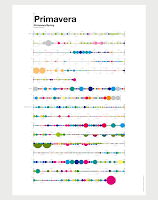Sound is produced when something vibrates. Every sound that reaches our ears and sounds the way it does is because of it's parts that comprise of it.
There are four main parts to a sound wave: wavelength, period, frequency and amplitude.
Wavelength - The wavelength is the horizontal distance between any two successive equivalent points on the wave. That means that the wavelength is the horizontal length of one cycle of the wave. The period of a wave is the time required for one complete cycle of the wave to pass by a point.
The longer the wavelength, the lower the pitch.The Shorter the wavelength, the higher the pitch.
Period - The period of a wave is the time for a particle on a medium to make one complete vibrational cycle. So, the period is the amount of time it takes for a wave to travel a distance of one wavelength.
Frequency - Every cycle of sound has one condensation, a region of increased pressure, and one rarefaction, a region where air pressure is slightly less than normal. The frequency of a sound wave is measured in hertz. Hertz (Hz) indicate the number of cycles per second that pass a given location.
Frequency and period are distinctly different, yet related, quantities. Frequency refers to how often something happens. Period refers to the time it takes something to happen. Frequency is a rate quantity. Period is a time quantity.
Amplitude - The amplitude of a sound is represented by the height of the wave. When there is a loud sound, the wave is high and the amplitude is large. Conversely, a smaller amplitude represents a softer sound. A decibel is a scientific unit that measures the intensity of sounds. The softest sound that a human can hear is the zero point. When the sound is twice as loud, the decibel level goes up by six. Humans speak normally at 60 decibels.
The higher the amplitude, the lower the sound. The lower the amplitude, the higher the sound.
Pitch - How the brain interprets the frequency of an emitted sound is called the pitch. We already know that the number of sound waves passing a point per second is the frequency. The faster the vibrations the emitted sound makes (or the higher the frequency), the higher the pitch. Therefore, when the frequency is low, the sound is lower.
Apart from these major divisions, the sound can still be divided into -
Timbre, Bass, Beats, Envelope, Attack etc.


















